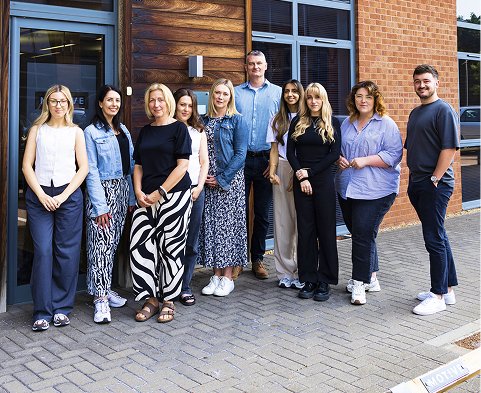The world of AI is still new territory but for PR pros who are willing to embrace it, it can be a great tool. From improved workflow to streamlining processes, AI can help boost creativity and deliver more impactful campaigns.
The key to using AI tools successfully is to use them thoughtfully and collaboratively. They will never be able to completely replace strategic thinking and emotional intelligence (two key components in PR) but it can support and inspire them. It’s best to think of AI like an assistant. It’s there to help make the job quicker and easier, taking time consuming tasks so you can focus on other areas that need real human input like managing relationships and creative thinking.
One of the biggest mistakes people make when it comes to using AI models like ChatGPT, Perplexity and Claude is expecting them to come up with perfect answers with little to no context. AI models are only as smart as you make them and when you know how to prompt them correctly and give them the right context, the answers are much more relevant and insightful.
.jpg)
The growth of AI in the workplace is prominent. It’s reported 58% of employees are now using AI at work and say that they’ve gained productivity and performance benefits from it. For PRs, AI is making some major shifts in our industry from changing the way we work to the way it affects our clients. It’s important to recognise where it can support you and how you can make the most of it.
What’s in this article:
- Why PR pros should embrace AI
- Different AI tools
- How PRs can make the most out of AI
- Inspire ideation
- Give AI models a role
- Newsjacking research
- List building
- Competitor research
- Analysing data
- Key takeaways
Why PR pros should embrace AI
In the PR and marketing world right now, the biggest conversation going on is the role of AI. AI can seem daunting or unnecessary to a lot of people but whether you like it or not, it’s here to stay. Embracing it doesn’t replace good PR but it is the best way to keep pace with the changing world of our industry and boost both your productivity and creativity.
The largest AI model, ChatGPT, has 400 million weekly active users worldwide, which is proof that people are embracing and adapting to AI in their day to day lives. For PRs this can be a powerful tool that can help with improving campaigns and streamlining processes such as ideation, competitor analysis and media list building.
.jpg)
One of the biggest misconceptions with AI is that it’s here to replace people which can often lead to people using AI models ineffectively or not using them at all. But instead of thinking AI will do your job for you, think of it almost like an assistant. When used thoughtfully, it should complement how you work and take care of time consuming tasks so you can improve your workflow.
PR is constantly changing and AI is now a key part of that. The sooner professionals embrace it and work alongside it and not against it, the easier they’ll find it to keep up with whatever comes next.
Different AI tools
The most popular AI tool the majority of people are familiar with is ChatGPT but there are plenty of others. While they can be similar, they have different strengths and weaknesses and some will be better for specific tasks than others.
Generally speaking, chatbots like ChatGPT, Perplexity and Claude will be most helpful to PRs. They’re good at quickly processing information, generating ideas and assisting with research. Each of them still have their own strengths with ChatGPT generally better for brainstorming, Perplexity better for fact checking and Claude for handling large complex data. With that being said, a lot of it will also come down to personal preference.
If you’re after something that can assist with writing and content creation, you’ll want to use something like Jasper or Rytr. Beyond text, there are also tools out there that can help create images, videos and other multimedia content if that’s relevant to your clients.
How PRs can make the most out of AI
Now we know why we should embrace AI and the different types of AI out there, we need to look at how we can use it to the best of its ability. We’ve summarised some of our favourite ways to incorporate AI into our everyday workflow.
Inspire ideation
Constantly coming up with fresh, new ideas in today's media landscape can be a challenge, especially when journalists' inboxes are filled with hundreds and hundreds of pitches to compete with. The goal with this isn’t to make Chat GPT come up with your ideas for you, it’s to help widen your creative lens, spark some inspiration and test angles.
Here are some prompts you could try asking Chat GPT in your next ideas session:
“What types of digital PR campaigns have been done recently by *insert competitors name here*”
“What public data source can help shape a digital PR campaign around *insert theme here*”
“What have been the current media trends this month in *insert industry name here*”
You should think of the responses generated as a starting point - not a final product. Use AI as a building block in the early stages of new campaigns to help direct your creativity and your own ideas.
Give AI models a role
Tools like Chat GPT and Perplexity AI are only as clever as you make them and the more context you can provide, the more useful and relevant the responses will be. A lot of people will often ask these AI models a question and expect it to deliver a perfect answer but without a clear prompt with clear input, you might not get an insightful response.
At the start of your prompt, assign Chat GPT or Perplexity a role. You can say something like “You’re a PR professional working at a digital PR agency..” or “You’re a senior account manager working with a client in [industry] and preparing a pitch for a lifestyle magazine on [topic]…”
Sentence starters like these can help set the tone and encourage AI to give you more relevant and useful responses. The clearer your prompt, the more valuable your output.
Newsjacking research
Newsjacking is a popular tactic in PR that can put clients at the centre of conversations that are already happening and help land coverage and links. Reactive PR has to be quick enough to catch the news cycle but thoughtful enough to add value to the story - and it’s not always easy finding an interesting take or hook that journalists haven’t heard of.
When spotting newsjacking opportunities for clients, it’s important to carry out background research on the topic to avoid drafting content that misses the mark or is just completely irrelevant. ChatGPT can speed up this process and help you carry out your background research much quicker. You can ask it to summarise articles for you or identify key issues by asking it something like:
“Summarise this article from The Guardian in five bullet points for me [insert link]”
OR
“Can you summarise the latest sugar tax debate and how this could affect food brands?”
Similar to the ideation process, AI tools can be useful in sparking ideas and spotting content gaps in the news. Remember to give ChatGPT context so it can respond with relevant ideas. Include in your prompt that you’re carrying out some reactive PR activity and need fresh angle suggestions for a breaking news story.
List building
One of the most crucial aspects of digital PR is building media lists and making sure you’re targeting the most relevant journalists who are likely to run your stories. Targeting the wrong journalists is essentially just a waste of time and can harm your reputation and relationships with some publications. That being said, building media lists and sifting through news articles to find relevant journalists can be time consuming but using AI tools can help you streamline the process and save time.
At Motive, we’ve been enjoying using ListIQ to help build our media lists and fill them with the most relevant journalists. List IQ allows you to scan through search engines like Google and select news articles relevant to the topic you’re writing about. It then uses AI algorithms to find and vet publicly available information on these journalists such as their emails, the content they cover and job title and puts this into a ready made spreadsheet for you.
Just like that you have a list of relevant journalists to target along with important information that can sometimes be time consuming and difficult to find.
Competitor research
Competitor research can help uncover successful strategies and content gaps in your client’s field and it's certainly something PRs should be keeping an eye on. For quick updates, ChatGPT can help summarise competitor campaigns, identify new content ideas that competitors haven’t picked up on and spot publications competitors have secured coverage in. Here are some prompts you may want to consider:
“Summarise the most recent digital PR campaigns by [insert competitor’s name]. What topics did they cover and how successful were they?”
“Give me a list of publications that [insert competitor’s name] has been featured in within the last 3 months. They should have a domain rating of 50 and above.”
“Based on [insert competitors name]’s recent PR campaigns, what angles and topics haven’t they covered?”
Analysing data
Whether you have a source of primary or secondary data from public reports or spreadsheets, sifting through it can be a timely and complex task.
Claude AI is a fantastic tool that can analyse lengthy and complex content in comparison to other AI models. ChatGPT for example is limited to processing shorter chunks of information to get the best outcome whereas Claude can manage an upload of up to 500 documents at once. This makes it much easier for diving into complex data or reports. Claude AI can summarise documents, spot key findings or identify trends, leaving you more time to build a compelling story.
For PRs who work on a lot of data heavy campaigns, this can offer a much quicker way to break down information and spot interesting story angles. It can save a lot of time when developing a campaign and allows you to focus more on pitching strategy and creativity.
Key takeaways
- Treat AI like an assistant. It should be used to compliment your workflow, not replace human skills.
- There are lots of AI models out there. ChatGPT, Perplexity, Claude and ListIQ are some of the most helpful for PRs.
- AI can help with a range of tasks. From ideation and data analysis to list building and competitor research.
- Give AI chatbots a role. This will help provide context to your prompts and generate better responses.
Contact us to learn how we’re using AI to deliver strong PR results: hello@motivepr.co.uk


.webp)

.jpg)

.jpg)
.jpg)
.jpg)

